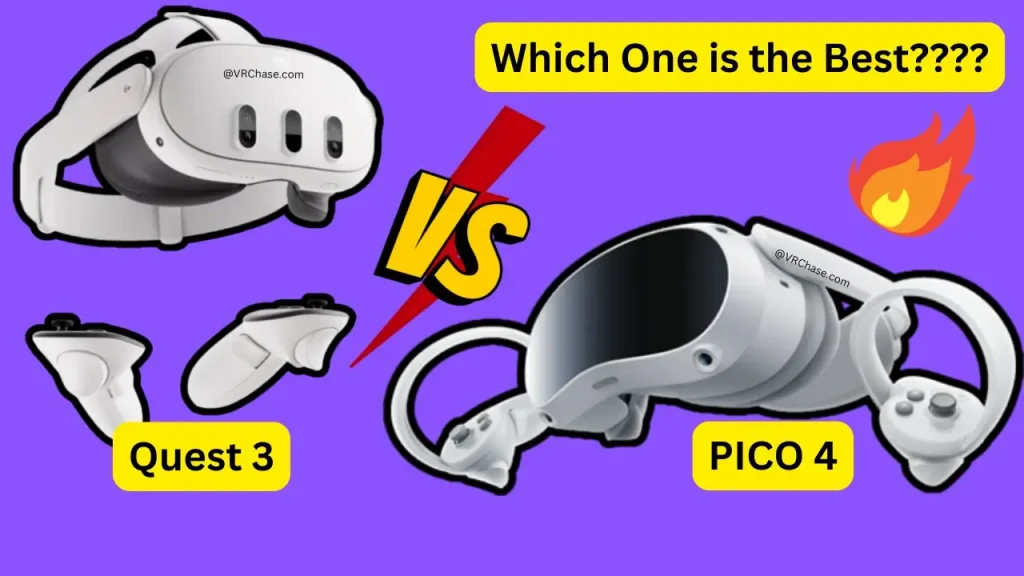Choosing the right VR headset can feel like being stuck in a boss fight you didn’t prepare for. On one hand, you’ve got the Pico 4, with its comfort and groundbreaking visuals, and on the other, the Meta Quest 3, offering raw power and an impressive game library. Both are highly hyped standalone VR headsets, but which one is truly the best for gamers?
Time to suit up! We’re breaking down the differences between the Pico 4 and the Quest 3—hardware, games, design, and all the important stuff you need to know to make an informed choice.
1. Hardware & Display
Screen Quality
A VR headset’s display is your window into another world, so it’s crucial to get this part right.
- Pico 4 comes in hot with 4K+ resolution (2160 × 2160 per eye) and pancake lenses, which offer vivid and sharper visuals. Plus, its slightly wider field of view adds a bit more immersion.
- Meta Quest 3 isn’t slouching either, delivering 2064 × 2208 resolution per eye but with more dynamic color range and clarity.
✅ Winner: Pico 4 – Those extra pixels and wider view give it a small edge for hardcore visual enthusiasts.
Processing Power
When it comes to powering intense gaming, the chip matters. A lot.
- The Pico 4 relies on the Qualcomm Snapdragon XR2 Gen 1, which gets the job done but is slightly behind in performance.
- The Quest 3, on the other hand, comes with the souped-up Snapdragon XR2 Gen 2, offering double the GPU power. This means smoother gameplay, better graphics, and less lag.
✅ Winner: Quest 3 – Gen 2 power trumps Gen 1 every day of the week.
Suggested: Is Your PC VR-Ready? Here’s How to Check
2. Comfort & Design
Weight Distribution
Comfort is king for long gaming sessions, and weight distribution plays a big role here.
- Pico 4 does an excellent job of balancing weight by placing the battery at the back, making it much easier on your neck during marathon sessions.
- The Quest 3 improves on the Quest 2’s front-heavy design but still feels a bit unbalanced compared to the Pico 4.
✅ Winner: Pico 4 – Better weight balance for long, sweat-free gaming hours.
Build & Strap Design
- The Pico 4 comes with a comfortable default strap—no need for extra accessories. It’s pretty much ready to go straight out of the box.
- The Quest 3’s default strap is functional, but if you want maximum comfort, you’ll likely need third-party upgrades.
✅ Winner: Pico 4 – Who doesn’t love comfort right out of the box?
3. Game Library & Software
Native Game Support
Your VR experience lives and dies by the games you can play.
- The Pico 4 focuses on solid ports but doesn’t have a huge standalone game library.
- Meanwhile, Quest 3 offers a massive library of VR games with exclusives like Asgard’s Wrath 2, plus integration with Meta Horizon Worlds.
✅ Winner: Quest 3 – Having access to top-tier native games makes all the difference.
Recommended: Cool Things to Do with Your Oculus Quest 2
PCVR Compatibility
For high-end gaming, you might want to stream PCVR games. How do these two stack up?
- Pico 4 connects to SteamVR via Streaming Assistant or third-party apps like Virtual Desktop. It’s solid but not as seamless.
- Quest 3 offers PCVR support via Air Link, Virtual Desktop, or a Link Cable. Plus, its optimization (courtesy of Meta’s ecosystem) tends to work a tad better.
✅ Winner: Tie – Both deliver strong PCVR support, but Quest 3 is marginally better optimized.
4. Tracking & Controllers
Hand & Controller Tracking
- Pico 4 sticks to solid inside-out controller tracking, but it lacks hand-tracking capabilities.
- Quest 3’s updated controllers, paired with improved hand tracking, deliver greater precision and tactile haptics. Plus, the new Touch Plus controllers ditch traditional tracking rings for a sleeker design.
✅ Winner: Quest 3 – More immersive tracking and improved controller feedback.
5. Price & Value
Cost Comparison
- Pico 4 undercuts Quest 3 in terms of price, making it a budget-friendly alternative without skimping on important features.
- Quest 3, while pricier, justifies the cost with superior gaming performance and a larger ecosystem of games.
✅ Winner: Pico 4 – If affordability is the priority, this is the way to go.
Also Check: How to Remove the Quest 3 Facial Interface?
Final Verdict: Which One Should You Buy?
Still torn? Here’s the TL;DR breakdown based on your needs:
Choose Pico 4 If:
- You value comfort and balance during long gaming sessions.
- You’re obsessed with crystal-clear displays and don’t mind a smaller game library.
- You’re primarily into PCVR gaming and don’t feel the need for standalone VR exclusives.
Choose Quest 3 If:
- You want the most powerful standalone headset for gaming and mixed reality.
- A larger game library with hit exclusives is non-negotiable.
- You plan to explore hand tracking and mixed reality features with your VR headset.
✅ Overall Winner: Quest 3 – With its stronger processing power, better tracking, and robust game ecosystem, the Quest 3 edges out as the ultimate choice for most gamers. That said, the Pico 4 remains a worthy alternative for PCVR-focused players on a budget.
Your Next Gaming Level
Whether you lean toward the Pico 4’s comfort or the Quest 3’s sheer power, VR gaming has never been more exciting. Ultimately, the best headset is the one that matches your gaming style and priorities—so take your pick and get ready to enter new dimensions!.

